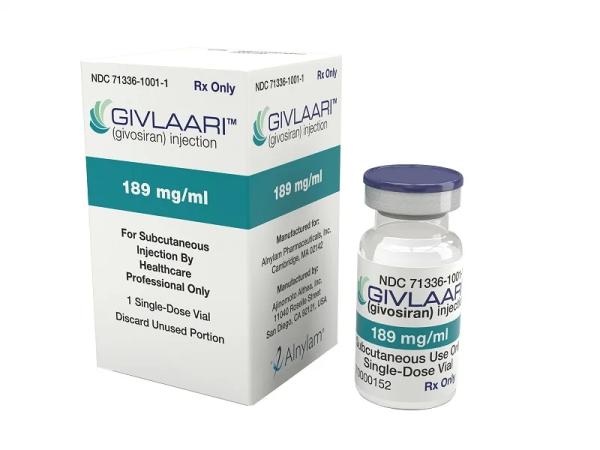Givosiran Dosage
Medically reviewed by Drugs.com. Last updated on Dec 2, 2024.
Applies to the following strengths: 189 mg/mL
Usual Adult Dose for:
Additional dosage information:
Usual Adult Dose for Porphyria
2.5 mg/kg subcutaneously once a month
Comments:
- Dosing is based on actual body weight.
- Administration should be performed by a health care professional.
Use: For the treatment of acute hepatic porphyria (AHP)
Renal Dose Adjustments
Mild to severe renal dysfunction (estimated GFR 15 to less than 89 mL/min/1.73 m2) and ESRD (estimated GFR less than 15 mL/min/1.73 m2): Data not available
Comments:
- Estimated GFR by the Modification of Diet in Renal Disease formula
Liver Dose Adjustments
Liver dysfunction: Data not available
If severe or clinically significant transaminase elevations develop during therapy:
- Interrupt treatment; after improvement, reduce the dose to 1.25 mg/kg subcutaneously once a month.
- If severe/clinically significant transaminase elevations do not recur at 1.25 mg/kg once a month, dose may be increased to 2.5 mg/kg subcutaneously once a month.
Precautions
CONTRAINDICATIONS:
- Known severe hypersensitivity (e.g., anaphylaxis) to the active component or any of the ingredients
Safety and efficacy have not been established in patients younger than 18 years.
Consult WARNINGS section for additional precautions.
Dialysis
Data not available
Other Comments
Administration advice:
- Health care professionals should administer this drug via subcutaneous injection once a month.
- For injection, use a 25-gauge or 27-gauge needle with 1/2-inch or 5/8-inch needle length.
- During administration, adequate medical support to manage an anaphylactic reaction should be readily available.
- Administer subcutaneously into abdomen, back or side of the upper arms, or thighs.
- Rotate injection sites.
- Do not inject into scar tissue or areas that are reddened, inflamed, or swollen.
- If injecting into the abdomen, avoid a 5 cm diameter circle around the navel.
- If more than one injection is required for a single dose, the injection sites should be at least 2 cm apart from previous injection locations.
- Administer this drug as soon as possible after a missed dose; resume dosing at monthly intervals following administration of the missed dose.
Storage requirements:
- Store at 2C to 25C (35F to 77F) in original container until ready to use.
Reconstitution/preparation techniques:
- Available as a ready-to-use single-dose vial that does not require additional reconstitution or dilution.
- Withdraw calculated injection volume using a 21-gauge or larger needle.
- Divide doses requiring volumes greater than 1.5 mL equally into multiple syringes.
- The manufacturer product information should be consulted.
Monitoring:
- Hepatic: Liver function tests (before starting therapy, every month during the first 6 months of therapy, and as clinically indicated thereafter)
- Hypersensitivity: For signs/symptoms of anaphylaxis
- Local: For injection site reactions
- Metabolic: Blood homocysteine levels (prior to and during therapy)
- Renal: Renal function (during therapy as clinically indicated)
Patient advice:
- Patients should understand the risks and symptoms of severe hypersensitivity reactions that may occur with treatment.
- This drug may elevate transaminase levels; laboratory testing is required monthly during the first 6 months of treatment and as clinically indicated thereafter.
- There is a risk of an increase in serum creatinine and a decrease in estimated GFR with this drug.
- Injection site reactions such as redness, pain, itching, rash, discoloration, or localized swelling may occur.
- This drug may elevate blood homocysteine levels.
More about givosiran
- Check interactions
- Compare alternatives
- Side effects
- During pregnancy
- Drug class: miscellaneous metabolic agents
- En español
Patient resources
Other brands
Professional resources
Other brands
Related treatment guides
See also:
Further information
Always consult your healthcare provider to ensure the information displayed on this page applies to your personal circumstances.


